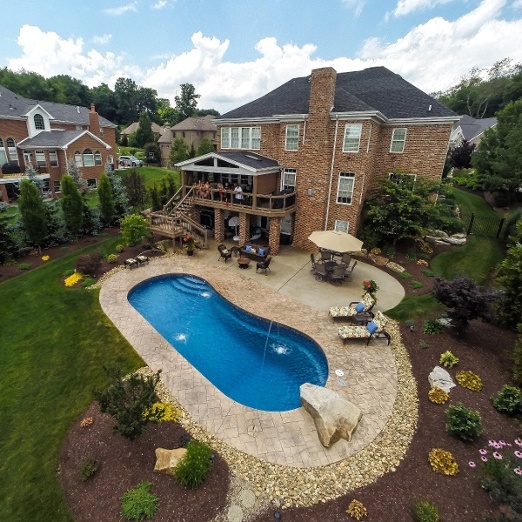We previously posted an article comparing the three main types of inground pools: fiberglass, concrete and vinyl liner pools, but today we are focusing on the two most built pools in our area, fiberglass swimming pools and concrete swimming pools.
If you have read any of our blog articles, then you now know the most durable inground pools are fiberglass pools and concrete pools (also known as gunite pools). This article is designed to provide you a quick comparison of the most commonly built pool types, including the pros and cons of each. We also have included a pool comparison chart for a quick reference of each type of pool advantages.
The Basics of a Fiberglass Pool
Fiberglass is a type of sturdy, resin mix that is reinforced with composite glass fibers. It is an ideal material for swimming pools because it is smooth, non-porous, strong and flexible. Fiberglass Pools are precision-made by applying resin, fiberglass and other composite strengtheners in layers to a prefabricated mold. As an example, Viking Pools, one of the leading manufacturers of fiberglass swimming pools, creates its pools using a 10-stage process that layers fiberglass multiple times with Vinyl Ester Resin (for durability and strength), a sturdy core of ceramic, carbon fibers or more fiberglass (for added strength), and embedded vertical support beams (for structure, strength and ease in lifting). The finished pools are shipped in one piece to the installation site.
Advantages
- Low Maintenance
- Time to Install
- Durability
- Lifetime Cost Low
- Countless Design Options
- Salt and Cleaning Systems
The Basics of a Concrete Pool
Concrete Pools, often referred to as gunite pool, as a pool building material has been a popular choice until recent years. Gunite is a mixture of sand and concrete that is sprayed onto surfaces at high velocity. Unfortunately, with the design flexibility concrete provides comes with a heavy price.
Advantages
- Durability
- Can Customize Shape and Size
Pool Comparison Chart
| Features |
Fiberglass Pools |
Concrete Pools |
| Structural Guarantee | Lifetime 100% | 1 Year |
| Maintenance Hours Per Week | 1 Hour | 8 Hours |
| Surface | Smooth | Rough |
| Time to Install Shell | 1-3 Days | 6-8 Weeks |
| Lifetime Cost of Ownership | Very Low | Very High |
| Painting | Never | Yearly |
| Quality Control | By Factory | By Installer |
| Type of Coping | Closed Beam | Concrete |
| Steps | Built In, Textured | Built In |
| Relocation Possibilities | Anytime | Never |
| Drainage of Pool | Never | Yearly |
| Objectionable Features | None | Expensive to build and maintain |
Learn more about the common pool types with the e-Book: Fiberglass vs Concrete here!
Related Articles
Planning Your Gorgeous New Fiberglass Pool Starts Here with Aquamarine Pools

